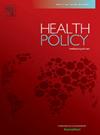按人头支付的发病率核算:英格兰初级医疗保健的基于个人的工作量公式
IF 3.4
3区 医学
Q1 HEALTH CARE SCIENCES & SERVICES
引用次数: 0
摘要
准确的基于需求的供资是有效和公平的初级保健供资的关键。大多数人头分配方案只使用基本的人口和地区特征。目的:我们利用在初级和二级保健中记录的发病率指标,开发了英格兰全科医生的头盖骨权重。方法:我们使用临床实践研究数据链(CPRD)与医院发作统计(HES)相关联的初级保健记录,收集了2018年4月1日注册的1397名全科医生的12,667,755名患者。使用线性回归模型,我们估计了患者年龄和性别、种族、地区贫困、新登记和发病率(涵盖20至209种疾病的四组指标)对成本加权临床预约的影响。我们纳入了实践固定效应来调整产能和生产率的差异。我们将患者特征系数作为需求权重应用于全国可用的数据,并计算了英格兰所有6892家诊所的加权患者。结果大多数患者(71%)每年至少有一次预约。每位患者的年平均工作量为110英镑,不同患者(范围为0- 882英镑)和实践(47- 179英镑)之间差异很大。工作量随着年龄和贫困的增加而增加,但当模型中包括发病率时,它们的直接影响减半。包括发病率扩大了第5和第95百分位数(从0.84-1.14到0.79-1.16)以及最贫困和最贫困十分位数(从0.96-1.04到0.95-1.06)之间的加权患者范围。结论以需求为基础的人均权重考虑了发病率和调整了无法解释的实践能力和生产力变化,增加了工作量差异,并将资源直接用于更贫困地区的实践。本文章由计算机程序翻译,如有差异,请以英文原文为准。
Accounting for morbidity in capitation payments: A person-based workload formula for primary medical care in England
Background
Accurate needs-based capitation is key to effective and equitable primary care funding. Most capitation schemes use only basic demographic and area characteristics.
Objective
We developed capitation weights for general practices in England using morbidity indicators recorded in primary and secondary care.
Methods
We used primary care records from the Clinical Practice Research Datalink (CPRD) linked with Hospital Episode Statistics (HES) for 12,667,755 patients registered with 1397 general practices on 1 April 2018. Using linear regression models, we estimated the effects on cost-weighted clinical appointments of patient age and gender, ethnicity, area-level deprivation, new registration, and morbidity (four sets of indicators covering 20 to 209 conditions). We included practice fixed-effects to adjust for differences in capacity and productivity. We applied the coefficients on patient characteristics as need-weights to data available nationally and we calculated weighted-patients for all 6892 practices in England.
Results
Most patients (71 %) had at least one appointment per-year. The average annual workload per-patient was £110, with large variations across patients (range £0-£882) and practices (£47-£179). Workload increased with age and with deprivation, but their direct effects halved when including morbidity in the model. Including morbidity widened the range of weighted-patient between practices at the 5th and 95th percentiles (from 0.84–1.14 to 0.79–1.16) and in the least and most deprived deciles (from 0.96–1.04 to 0.95–1.06).
Conclusion
Needs-based capitation weights accounting for morbidity and adjusting for unexplained variations in practice capacity and productivity increase workload differentiation and direct resources toward practices in more deprived areas.
求助全文
通过发布文献求助,成功后即可免费获取论文全文。
去求助
来源期刊

Health Policy
医学-卫生保健
CiteScore
6.40
自引率
6.10%
发文量
157
审稿时长
3-8 weeks
期刊介绍:
Health Policy is intended to be a vehicle for the exploration and discussion of health policy and health system issues and is aimed in particular at enhancing communication between health policy and system researchers, legislators, decision-makers and professionals concerned with developing, implementing, and analysing health policy, health systems and health care reforms, primarily in high-income countries outside the U.S.A.
 求助内容:
求助内容: 应助结果提醒方式:
应助结果提醒方式:


